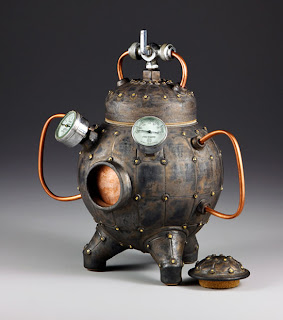I followed a course in carbon printing in Middelburg, The Netherlands at Polychrome (Kees Brandenburg).
Carbon printing is an old photographic procedure, in which carbon black (lamp black) was used for making black & white prints. This technique is (probably) developed by Alphonse Poitevin in 1855. This technique was adapted in 1868 by Louis Arthur Ducos du Hauron into color printing with pigments. These techniques were commonly used well into the middle of the 20th century.
Carbon printing is - besides gum printing - one of the most durable and lasting printing techniques. The carbon prints will stand out as if they were made yesterday among all kinds of prints from the 19th century available in foto archives.
How does carbon printing work? A sheet of paper is coated with a layer of pigmented gelatin. When the paper has dried it is made sensitive to light with dichromate (applied with a brush). After the paper has dried again, it can be exposed by contact printing with a negative. The exposed paper is then put under water and it makes contact with an other sheet of paper: the final carrier of the image. Some light pressure is applied to this sandwich for some time. When removing the sandwich from the water, keep the sandwich together and wash it gently in warm water. The original sheet of paper will come lose from the pigmented layer: it is now transferred to the new sheet of paper. This sheet with the image is now washed with cold water and will harden.
This technique is still taught in The Netherlands in Middelburg by Kees Brandenburg.
There is an english forum about carbon printing.
A free english handbook (100 pages) can be downloaded here: www.carbonprinting.com.
A free english handbook (100 pages) can be downloaded here: www.carbonprinting.com.
Interesting links:
- Polychrome (Kees Brandenburg)
- workshop carbon printing in KM 70 from Kees Brandenburg (dutch language)
- carbon printing on wikipedia (carbon print)
- Alternative Photography (english website)
- english article from Sandy King on unblinkingeye.com
- example of modern use of “color carbon printing”
- historical processes forum (bostick & sullivan)
- The Carbon Works (website)
| (carbon print from 1878 made by Thomas Annan) |





























